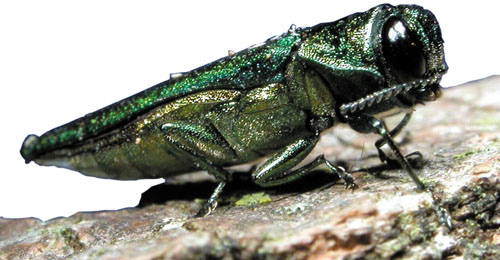The Emerald Ash Borer: What should we do?

By now, most Vermonters have heard that the Emerald Ash Borer (EAB) has been found in Vermont. This invasive exotic insect, native to eastern Asia, leads to over 90% mortality in our native ash trees. EAB has been found in several locations in Vermont, including in South Hero and Bristol, very close to the boundaries of Chittenden County. As this insect threatens the ash trees on our streets, backyards and woodlots, what should we do?
EAB is a green bullet-shaped beetle about ½ inch in length. In its native range EAB targets stressed ash trees, but in North America it attacks healthy trees of all species of ash. The way they kill ash trees is simple; adults lay eggs in ash bark, which hatch into larvae. As they grow, these larvae feed on the inner-bark of the tree, carving “galleries” (tunnels) which impair the tree’s ability to transport nutrients and sugars throughout its trunk. Eventually, this causes the tree to die.
Make a plan. As far as we know, EAB is not yet in Chittenden County, although it will be sometime in the near future. Whether you are a forest landowner, a homeowner with a backyard ash or a municipality, you should think about the effect that losing your ash trees will have on your interests.
For homeowners with backyard ash trees, budget for EAB. Your options are essentially to remove and replace your ash trees or to “treat” them with systemic insecticide, both of which can be costly. If you choose to remove and replace your trees, do so with a diversity of native tree species, rather than a single species. Note that the pre-emptive removal of ash trees before they become infested may be significantly cheaper than removing infested/dead trees. Even if you want to hold-off the removal of your ash trees, planting your replacement tree now can lessen the aesthetic impacts of the loss of your ash trees. If you choose to “treat” your trees, note that this is an activity which is initially cheaper but must be repeated every 2-3 years indefinitely to keep your tree EAB-free. Whether you choose to remove/replace or to treat, contact an arborist to do so.
Most municipalities in Chittenden County and throughout Vermont are employing a hybrid approach — identifying some ash street trees to treat and beginning to remove and replace most others, recognizing that waiting until EAB arrives will result in many hazard trees and extreme aesthetic impacts all at once. Pre-emptive removal also allows municipalities to spread the cost of removals and replacements out over time.
If you own a woodlot, you can choose to take an active or a passive approach. There is nothing you need to do; cutting your ash trees won’t mitigate the effects of EAB or slow its spread. If you do nothing your ash trees will eventually die, and while the loss of ash is a blow for forest health, dead wood is an asset from a forest ecology perspective. If you want to capture the value in your ash trees, set up a timber harvest that goes beyond simply cutting all the ash; the loss of this species threatens the health and resilience of our forests, and poorly-planned harvesting will only exacerbate the stresses it causes. Use forest management that improves the diversity of your forest and encourages your healthiest trees, and retain plenty of healthy ash in case they are resistant to EAB. Controlling invasive exotic plant species is also critical; we need to ensure that native tree species, not invasives, regenerate following the death of our ash trees. Contact a forester and check out VTCutWithConfidence.com for some guidance on setting up a high-quality timber harvest.
Time is our greatest asset in dealing with EAB, giving us more opportunities to respond to this issue proactively, pre-emptively, and robustly. While we cannot keep EAB from spreading all together, we can give ourselves more time by following Vermont’s “Slow the Spread” guidelines and other best practices found at https://vtinvasives.org/land/emerald-ash-borer-vermont . Following these rules benefits our neighbors and communities by giving everyone the chance to respond to this issue.
To see pictures of the telltale signs and symptoms of EAB, report EAB, and/or to learn more about invasive exotic plants, visit VTInvasives.org.
Ethan Tapper is the Chittenden County Forester. He can be reached at (802)-585-9099, ethan.tapper@vermont,gov, or at his office at 111 West Street Essex Junction.
Image: Flickr / USDAgov
